Great White Hype
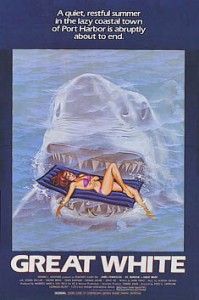 In 1975, the motion picture Jaws redefined the horror movie. Its phenomenal box office performance garnered the film a string of increasingly lackluster sequels and a slew of imitators that has only been rivaled by Star Wars. These cash-ins ranged from shark documentaries to any kind of nature on the loose concoction filmmakers could dream up. Mako: Jaws of Death, Piranha, Grizzly, Tentacles, Orca, Barracuda, and even The Car were all inspired by this monetary success and were the beginning of a new genre of “mindless killing machine” films that appeared in the first few years following Jaws release. While they had been quick to respond with the mildly entertaining, not to mention financially lucrative, giant octopus flick Tentacles, the Italian film industry would also produce a film that would go down in history as one of the most blatant rip-offs to ever actually play in movie theaters all over the world. That film was L’ Ultimo Squalo, AKA The Last Shark, or, as it was known during its two-week run in American theaters – Great White.
In 1975, the motion picture Jaws redefined the horror movie. Its phenomenal box office performance garnered the film a string of increasingly lackluster sequels and a slew of imitators that has only been rivaled by Star Wars. These cash-ins ranged from shark documentaries to any kind of nature on the loose concoction filmmakers could dream up. Mako: Jaws of Death, Piranha, Grizzly, Tentacles, Orca, Barracuda, and even The Car were all inspired by this monetary success and were the beginning of a new genre of “mindless killing machine” films that appeared in the first few years following Jaws release. While they had been quick to respond with the mildly entertaining, not to mention financially lucrative, giant octopus flick Tentacles, the Italian film industry would also produce a film that would go down in history as one of the most blatant rip-offs to ever actually play in movie theaters all over the world. That film was L’ Ultimo Squalo, AKA The Last Shark, or, as it was known during its two-week run in American theaters – Great White.
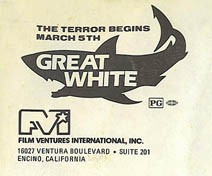 Imitation may be the sincerest form of flattery but it can also land you in a lot of legal trouble when it extends to copyright infringement. Foreign countries have often taken a different view of the severity of plagiarism to the point that some of their film makers often recycle plots, characters, and even special effects footage from US films into their products without authorization. These companies seldom make any attempts to release their films outside of their own country so they are only subject to their own legal system. Great White would probably only be a tacky footnote in cinematic history had it not actually received a highly publicized national release in the United States that probably still has entertainment lawyers scratching their heads in confusion to this day.
Imitation may be the sincerest form of flattery but it can also land you in a lot of legal trouble when it extends to copyright infringement. Foreign countries have often taken a different view of the severity of plagiarism to the point that some of their film makers often recycle plots, characters, and even special effects footage from US films into their products without authorization. These companies seldom make any attempts to release their films outside of their own country so they are only subject to their own legal system. Great White would probably only be a tacky footnote in cinematic history had it not actually received a highly publicized national release in the United States that probably still has entertainment lawyers scratching their heads in confusion to this day.
 In 1980, following the success of Jaws in 1975 and Jaws 2 in 1978, Italian director Enzo G. Castellari (1990: The Bronx Warrior) decided to combine some of the best scenes in both films and make the ultimate Jaws movie. A US release must have been in the works from the start because he followed the game plan from Tentacles and tried to Americanize the cast as much as possible. James Franciscus (Beneath the Planet of the Apes) was hired to play the hero who also happens to be a shark expert and Vic Morrow (Lord this man deserved better movies) was hired to play the crusty sea captain. Morrow’s performance and character is such a dead-on copy of Quint from Jaws that you would almost swear he was channeling the spirit of the recently deceased Robert Shaw who had just died in 1978.
In 1980, following the success of Jaws in 1975 and Jaws 2 in 1978, Italian director Enzo G. Castellari (1990: The Bronx Warrior) decided to combine some of the best scenes in both films and make the ultimate Jaws movie. A US release must have been in the works from the start because he followed the game plan from Tentacles and tried to Americanize the cast as much as possible. James Franciscus (Beneath the Planet of the Apes) was hired to play the hero who also happens to be a shark expert and Vic Morrow (Lord this man deserved better movies) was hired to play the crusty sea captain. Morrow’s performance and character is such a dead-on copy of Quint from Jaws that you would almost swear he was channeling the spirit of the recently deceased Robert Shaw who had just died in 1978.
If you have seen Jaws and Jaws 2 you already know 90% of the plot of Great White. A sleepy little tourist town is invaded by a giant, human hungry, great white shark right before a big event and it’s up to a couple of the local residents to stop the carnage. Along the way we get a mayor who won’t close the beaches, a buoy that gets stuck to the shark and pops out of the water whenever it is close by, and night time skinny-dipping. About the only unique elements added are that the town, Port Harbor, is supposed to be in Florida (what did we ever do to you, Italy?) and there is a sailboard race going on as part of the festivities. The film’s climax has the shark being blown up just like in Jaws but this time it happens after it chows down a character that was wearing a belt of explosives. Ironically, Universal would proceed to rip-off the ending of this rip-off for Jaws 3-D a few years later!
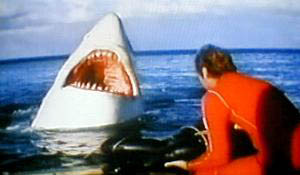 For most of the film, the shark is represented by underwater stock footage that would actually look pretty good if it weren’t so dark. The “shadow shark” effect in the badly lit underwater scenes is kind of cool at first but it gets annoying fast and really cheats the payoff of the shark’s demise. As bad as this is though, nothing can compare to the “animatronic” shark head that rears its ugly self throughout the film. Aside from looking like it was borrowed from a miniature golf course, the head only rises at a 45-degree angle so every time it breaks the surface looks almost identical. The producers must have really thought they had something though because the head is afforded more screen time than it deserves. It really seems like all the heroes had to do was sit on the boat with bats and wait for the shark to eventually pop up. At least that ending would have been easier on the eyes than the murky underwater explosion.
For most of the film, the shark is represented by underwater stock footage that would actually look pretty good if it weren’t so dark. The “shadow shark” effect in the badly lit underwater scenes is kind of cool at first but it gets annoying fast and really cheats the payoff of the shark’s demise. As bad as this is though, nothing can compare to the “animatronic” shark head that rears its ugly self throughout the film. Aside from looking like it was borrowed from a miniature golf course, the head only rises at a 45-degree angle so every time it breaks the surface looks almost identical. The producers must have really thought they had something though because the head is afforded more screen time than it deserves. It really seems like all the heroes had to do was sit on the boat with bats and wait for the shark to eventually pop up. At least that ending would have been easier on the eyes than the murky underwater explosion.
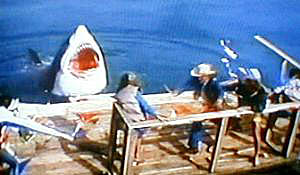 As obvious a bad idea as this film was, nothing is more astounding than the fact that it not only received a US theatrical release, but a heavily promoted one at that. Film Ventures International (FVI for short or Film Vultures as many in the industry have called them) apparently thought The Last Shark was their ticket to the big leagues. In 1981, a massive advertising campaign, estimated by some to be a staggering four million dollars but this is probably an inflated figure, was launched which included trailers, radio and television spots, a “pop up” full color pressbook, and no less than three different styles of movie posters. The only thing the promotions lacked was a good catch phrase like “just when you thought it was safe to go back to the movies”!
As obvious a bad idea as this film was, nothing is more astounding than the fact that it not only received a US theatrical release, but a heavily promoted one at that. Film Ventures International (FVI for short or Film Vultures as many in the industry have called them) apparently thought The Last Shark was their ticket to the big leagues. In 1981, a massive advertising campaign, estimated by some to be a staggering four million dollars but this is probably an inflated figure, was launched which included trailers, radio and television spots, a “pop up” full color pressbook, and no less than three different styles of movie posters. The only thing the promotions lacked was a good catch phrase like “just when you thought it was safe to go back to the movies”!
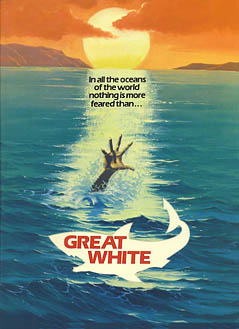 The posters for this movie are so delightfully tacky that they have risen above the film and gained a cult status of their own. The key one-sheet features a drawing of a woman on a raft from an overhead view while the head of a truly massive and cool-looking shark rises from the water directly beneath her. This obviously exaggerated take off of the original Jaws artwork from a different angle was all it took to get my fourteen-year-old butt in a seat on the opening weekend! The other two styles feature a take-off on the sunset advanced style of Jaws 2 with a hand sticking out of the water instead of a fin (similar to the cover of the pressbook) and a more educational (and less interesting) “shark facts” poster that attempts to educate the audience prior to insulting them with the film!
The posters for this movie are so delightfully tacky that they have risen above the film and gained a cult status of their own. The key one-sheet features a drawing of a woman on a raft from an overhead view while the head of a truly massive and cool-looking shark rises from the water directly beneath her. This obviously exaggerated take off of the original Jaws artwork from a different angle was all it took to get my fourteen-year-old butt in a seat on the opening weekend! The other two styles feature a take-off on the sunset advanced style of Jaws 2 with a hand sticking out of the water instead of a fin (similar to the cover of the pressbook) and a more educational (and less interesting) “shark facts” poster that attempts to educate the audience prior to insulting them with the film!
Whatever the actual advertising budget was for Film Ventures, the campaign paid off better than they could have ever anticipated and ultimately to their detriment. In addition to attracting a strong audience for the film’s opening weekend (the theater I was in was packed), the promotions also attracted the attention of Universal Studios who promptly filed an injunction against the picture and had it pulled from theaters only two weeks in to a successful run! At this point it must have finally dawned on FVI that they were never going to get away with this carbon copy and the film has never seen any type of legal exhibition or release in the United States since that time.
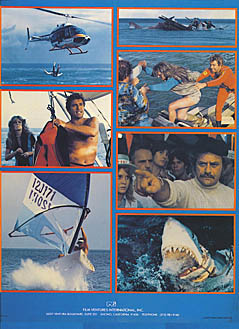 There are numerous cinematic imitations of Jaws that are far worse than Great White, which even manages a certain charm in its almost complete disregard for originality, but no film before or since has been such a blatant copy. The only way this film could have become established in the US is if Universal had purchased it and called it Jaws 3 (or better yet Jaws 1 + 2). Even if they were slow on the uptake in letting the film get released, Universal had better sense than to try to pass this off on the public. Oddly, watching this film again over twenty years after its aborted US release, I realized that it was really just ahead of its time for the market it needed. If the script for Great White were filmed today with a better budget and major studio involvement, it would be called Jaws and sold to the public as an updated “re-imagining” of the original in a form modern audiences could better appreciate. As long as Tim Burton had his name attached to it and Johnny Depp and Mark Wahlberg got to play the scientist and the sea captain, I am sure its financial success would be guaranteed!
There are numerous cinematic imitations of Jaws that are far worse than Great White, which even manages a certain charm in its almost complete disregard for originality, but no film before or since has been such a blatant copy. The only way this film could have become established in the US is if Universal had purchased it and called it Jaws 3 (or better yet Jaws 1 + 2). Even if they were slow on the uptake in letting the film get released, Universal had better sense than to try to pass this off on the public. Oddly, watching this film again over twenty years after its aborted US release, I realized that it was really just ahead of its time for the market it needed. If the script for Great White were filmed today with a better budget and major studio involvement, it would be called Jaws and sold to the public as an updated “re-imagining” of the original in a form modern audiences could better appreciate. As long as Tim Burton had his name attached to it and Johnny Depp and Mark Wahlberg got to play the scientist and the sea captain, I am sure its financial success would be guaranteed!
